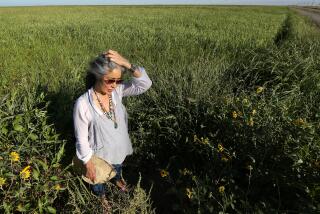Japan Agrees to End Ban on Imported Rice
- Share via
TOKYO — Japan formally agreed early today to end a decades-old ban on imported rice, thereby bringing the world a major step closer to a sweeping accord on trade and giving a quick boost to California agriculture in the bargain.
In what he called a “painful, heartbreaking decision,” Prime Minister Morihiro Hosokawa told a pre-dawn news conference that Japan will accept a partial opening of its rice market to help bring a successful conclusion to world trade negotiations under way in Geneva.
Japan’s ban on foreign rice--with the exception of emergency imports during crop shortfalls--was viewed as a maddening symbol of Japanese intransigence on trade. Japan’s limited opening, though far from removing structural trade barriers the United States has long complained of, could signify a new willingness to open its markets.
The total ban had been one of the most contentious issues in seven years of international talks under the General Agreement on Tariffs and Trade (GATT), which now faces a Wednesday deadline for conclusion.
Growers in California, Australia, Thailand and other regions are able to grow comparable rice at far lower cost than Japan, and the United States and other countries insisted that the issue had to be resolved to bring the GATT talks to a successful conclusion.
But Japan’s influential rice farmers, the island-nation’s concern for self-sufficiency and the important cultural role of rice made imports a powerful domestic issue, one even deemed capable of unraveling the government’s new ruling coalition.
But the impending GATT resolution and an emergency shortage of rice in Japan, which forced the government to temporarily open its rice markets last month, laid the groundwork for today’s decision, which had been expected by the international community.
The announcement was made just a day after the first emergency boatload of California rice docked in Japan, where it was greeted by protesting farmers warning that foreign rice is laden with pesticides and therefore unsafe.
Under terms of the agreement accepted today, Japan will import at least 4% of its annual rice needs of 10 million tons beginning in 1995, increasing to 8% over six years. About half of those totals, or 200,000 tons the first year, are expected to come from the United States and the balance from Australia and the Far East.
Because California is the only American producer that grows the medium-grain, japonice rice preferred as table rice by the Japanese, the entire 200,000 tons will likely come from the state’s growers, who this year produced about 1.5 million tons overall. About two-thirds of California’s rice is sold in the United States, much of it for cereal and snack foods.
Ralph S. Newman Jr., president of Farmers’ Rice Cooperative in Sacramento, which markets 40% of the state’s rice, said that limits on water and suitable land mean growers don’t have much flexibility to boost production to meet increased demand. About 450,000 acres were planted this year, and farmers could realistically add only about 50,000 acres, he said.
But Newman added that the opening of Japan’s market, the North American Free Trade Agreement and the expected GATT subsidy cutbacks in such European rice nations as Spain and Italy--where production costs are double California’s--will trigger a worldwide reshuffling of rice acreage as well as of other commodities.
“That will help us, because as subsidies are lowered, our natural competitive advantage begins to emerge,” said Newman, whose organization also favors the phase-out of U.S. price-support programs for rice.
Most California rice is produced in the Sacramento Valley, between Sacramento and Chico, where the clay-like soils can hold water for months with little seepage.
Already, Japan’s entry into what is a thinly traded world rice market--only about 5% of all rice is consumed outside the country where it is grown--has sent rice prices soaring in a year of poor rice crops nearly everywhere but California.
As a result, a bumper crop that had state growers worried about a surplus is now in such high demand that payments to California farmers for this year’s crop will likely jump by as much as one-third, to $400 million, Newman said.
In Tokyo, Hosokawa’s announcement was delayed by the initial refusal of the Socialist Party, part of the seven-party ruling coalition, to accept the decision. The Socialists agreed to support Hosokawa only after days of political theater, which appeared to mix some real political infighting with a calculated effort to display the greatest reluctance before yielding to the inevitable.
Finally, after midnight today, the Socialists concluded a leadership meeting by announcing that while in principle they still opposed the opening of the rice market, in practice they had no choice but to go along with Hosokawa’s decision rather than bring about the collapse of the government.
A Cabinet meeting was then quickly held to ratify the decision. It was nearly 4 a.m. when Hosokawa finally announced acceptance.
Despite all the heated rhetoric, the limited opening of Japan’s rice market called for in the GATT agreement will not have any great immediate impact on either consumers or farmers in Japan. It also is not particularly unpopular among ordinary Japanese.
Holley reported from Tokyo and Woutat from Sacramento.
More to Read
Inside the business of entertainment
The Wide Shot brings you news, analysis and insights on everything from streaming wars to production — and what it all means for the future.
You may occasionally receive promotional content from the Los Angeles Times.










